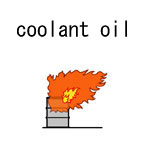| Case Name |
Ignition and fire of atomized coolant oil caused due to electrostatic charge during rolling at a rolling machine |
| Pictograph |

|
| Date |
August 15, 1989 |
| Place |
Kusatsu. Shiga, Japan |
| Location |
Nonferrous metal factory |
| Overview |
While aluminum foil was being rolled with the rolling mill, the coolant oil suddenly caught fire. It was probably caused due to electrostatic discharge of an oil pan that received sprayed coolant oil. |
| Incident |
A fire occurred during manufacturing of aluminum foil at a rolling mill. The oil pan to receive coolant oil was charged, then coolant oil in the pan was ignited due to static electricity, and an explosion occurred. Although an operator activated a fire-extinguishing device, it did not work, and the fire spread. The coolant oil was sprayed at 38-40 °C, 600-800 L/min. |
| Processing |
Consumption and usage |
| Substance |
Coolant oil |
| Type of Accident |
Fire |
| Sequence |
A fire occurred during the second(210 -> 130 μm thick) stage after finishing the first stage(300 -> 210 μm thick) at the aluminum foil rolling mill.
A fire broke out from the coolant oil receiver at the bottom of the rolling mill.
The fire ignited the coolant oil spraying at the rolling mill.
Operator switched on Halon 1301unit.
The rolling mill was stopped urgently and Halon 1301 was sprayed to the rolling mill.
The spray was not effective and the fire spread. |
| Cause |
Sprayed coolant oil was electrified by static electricity, which accumulated in an oil pan, discharged a spark and ignited the coolant oil. Although the extinguishing device started operation, it did not work effectively and the damage expanded. |
| Response |
Workers tried to extinguish the fire with a fire extinguishing device, but it was not effective. |
| Countermeasures |
An antistatic agent should be added to coolant oil.
Measurement of electrification should be periodically carried out.
Education on fire prevention for workers should be reinforced. |
| Knowledge Comment |
When oil is sprayed, static electricity is generated, and it is charged if the oil pan is isolated. The facilities, which are made taking this phenomenon into consideration, are required. |
| Background |
There might have been insufficient awareness of safety of all workers, considering their inadequate static electricity protection measures, insufficient fire extinguishing capacity, and no periodic inspections.
There also might have been inadequate knowledge of coolant oil. |
| Reason for Adding to DB |
Example of fire with non-effective fire-extinguishing activities |
| Scenario |
| Primary Scenario
|
Poor Value Perception, Poor Safety Awareness, Inadequate Risk Recognition, Insufficient Analysis or Research, Insufficient Prior Research, Material Property, Ignorance, Insufficient Knowledge, Insufficient Study, Planning and Design, Poor Planning, Poor Design, Usage, Operation/Use, Usage of Equipment/Material, Bad Event, Electrical Failure, Accumultion of Electricity, Secondary Damage, External Damage, Fire, Loss to Organization, Economic Loss, Direct Monetary Damage 730 million yen
|
|
| Sources |
Fire Disaster Management Agency, Major accident case, Fire in aluminum foil rolling mill, Accident case of dangerous materials, pp. 34,302-303
|
| Physical Damage |
1451 square meters out of a 7788 square meters factory burned. A lighting system and part of the ceiling burned. Many machines were damaged. Many kinds of machine oil and aluminum products were damaged. |
| Financial Cost |
¥ 73 million (Accident cases of dangerous materials) |
| Notes |
Static electricity causing ignition, Insufficient investigation of facilities |
| Field |
Chemicals and Plants
|
| Author |
WADA, Yuji (National Institute of Advanced Industrial Science and Technology)
TAMURA, Masamitsu (Center for Risk Management and Safety Sciences, Yokohama National University)
|
|